World Cup Preview: France
We preview France, a team hoping to avenge their Euro 2016 final defeat behind stable organization, threatening attacking transitions, and one of the most talented squads in the tournament.
Author’s Note: Some of the graphics feature players that were not called up to the final 23 man roster. As a result, omitted players relevant to the graphic will be referred to be their position if they featured in the scene. Some of the numbers worn by players in a graphic are not presently worn by that same player. The status of Kylian Mbappe’s ankle injury suffered in training is also unknown at the time of publication – we will treat it as if he will play decisive matches.
France will have their eyes on the prize for this World Cup, hoping to mirror the same feat that manager Didier Deschamps himself accomplished as a player twenty years prior. Loaded with ability across the roster, Les Bleus make a case for having the best squad in the tournament.
Unfortunately, the World Cup is not played on paper or in Twitter threads. Rather, it is played on a complex grass cauldron filled with unpredictability, randomness, emotion, and the pressure of hundreds of millions eyes from across the globe watching. With this in mind, Deschamps has organized his team to attempt to get the proper hybrid between stability and entropy. Primarily set up in a 4-3-3 base formation, the defense and midfield participates in patient, cautious possession, with a secondary focus on limiting counter attacks. The forward line brings wonderful individual quality with equal parts strength, speed, and improvisational craft.
Out of possession, this focus on stability is equally apparent, only moving to pressure when winning the ball is almost a certainty. France elect to soak up pressure instead, creating the ideal situation for the French counter attack, the area where they thrive most.
However, with some lackluster displays at times, questions have been raised about whether Didier Deschamps is getting the best out of their players. After losing the European Championships on their home soil, this World Cup could be the last chance for Deschamps to make his case with Zinedine Zidane waiting in the wings.
Squad
Entering the tournament, the biggest comparative advantage that the French have compared to other contending nations is the amount of quality available in the player pool. The past decade has seen numerous highly prized talents emerge from French academies, who have become some the most lucrative exporters of players in the world. New players are emerging so quickly that the young stars that were the hot focus of the European Championships have now been replaced and subsequently omitted from the World Cup squad two years later.
Given the pool available, Deschamps faced several challenging decisions about who to select, and the proper disciplinary actions for misconducts surrounding players that were pivotal in prior years. Karim Benzema, one of the world’s best strikers, is not included in the squad as a consequence of a blackmailing scandal surrounding former National Team member Mathieu Valbuena. Other omissions were hotly coveted on the transfer market just recently, with fees in excess of 50 million Euros for some of them.
Besides Liverpool, each of the top six clubs in the English Premier League each have a player deemed surplus to requirements by the manager. Rather than bring players such as Anthony Martial, Alexander Lacazette, and Aymeric Laporte, Deschamps preferred to reward the strong performances of Nabil Fekir, Florian Thauvin, and Presnel Kimpembe in Ligue 1. The list of notable exclusions doesn’t end there, with Kingsley Coman, Layvin Kurzawa, Dimitri Payet (mainly due to injury), and the controversial case of Adrien Rabiot being other marquee names left at home.
Regardless of who didn’t make it, there is a solid case that this France team is the most complete group of players since their backyard victory in 1998. The drop-off between the star players and those who may not feature in a single match this tournament is minimal, providing a myriad of options for France to turn to in the case of injuries or suspensions.
France possess what may be the strongest centre back partnership in international football in Raphael Varane and Samuel Umtiti, who have been mainstays for two of biggest clubs in world football. The mercurial Paul Pogba will likely be central to any success that the French have, with N’Golo Kante being the keystone for the side. For their goals, Antoine Griezmann and Kylian Mbappe will be primary sources of attacking inspiration.
Even if this France side doesn’t lift the trophy in Russia, they will still be considered top-end challengers for Qatar 2022 based off the quality of the squad alone. All of those players mentioned in the last paragraph are 27 or under, and it is not impossible that Kylian Mbappe wins player of the tournament as a teenager if France win the tournament. Other electrifying young stars like Ousmane Dembele, Thomas Lemar, and Benjamin Mendy add spectacular attacking quality to the mix as well. In a nation with the youngest head of state among the G-7, it is fitting that they will also be the most dependent on their greenhorns of the main contenders in Russia.
L’attaque
Justifiably so, the key players of France get a lot of focus from opposing coaches and fans when it comes to discussion the national team. Nevertheless, exploring the dynamics among the whole selection is integral to understanding both the strengths and the weaknesses of the Deschamps era. For all the quality they possess, they are capable of dominating teams in a more consistent and entertaining way. Yet stability acts as the guiding principle for circulation and player movements, leading to unintended consequences in possession.
Building Up
With stability at the forefront, France subsequently circulate the ball in a patient fashion with a lower risk profile. Rarely do the French play long passes in behind in an attempt to stretch the game, or even passes that bypass the midfield and go directly to the forwards. This means that circulation is sequentially played between lines mostly, with midfielders almost exclusively being the source of passes that forwards receive.
In addition, the left side is strongly preferred as their side to build up. Samuel Umtiti is capable of playing quite difficult entry passes into the interior, and with other skillful players like Pogba and Mendy frequenting the left, a natural focus on that side emerges. Plus, the left fullbacks are more attacking minded than the right side. This trend manifests itself to the tune of the right mainly being used to recycle possession and the left will have more penetration and incisive play. Either way, wing circulation is key to the development of attacks for the French.
During the construction of their attacks, their circulation is risk averse in multiple ways. If opponents step up on goal kicks or after conceding possession to pressure their build up, the goalkeeper will opt to simply kick the ball long and evade the pressure rather than play through it. When in the flow of play, the distances of the passes themselves are shorter, with the ball carrier oftentimes playing the closest or second closest option to him if it makes sense for him to receive. This can lead to periods of horizontal circulation among the back four, as during the time the ball travels across the back, France’s midfielders will move into spots where they can receive upcoming passes.
In the defensive half of play, passes to the fullbacks are meant to attract the opposition toward the wings with the intent of creating space in the centre. Bounce back passes where the receiver plays back to the passer in one touch are common during this phase of their attack, as by moving the ball quickly away from the wing, defenders will have to recover back toward the middle and France can find their midfielders feet in the subsequent openings.
Secondly, the possession is less risky due to the positioning of the central midfielders. Generally, France will build up in a situational 4-1-2-1-2, forming a diamond in the middle. Antoine Griezmann acts as a 10, drifting into spaces in search of the ball as the link between the midfielders and forwards, typically between the opposition lines as well. He has almost total freedom in this team, meaning France is organized behind him in a way to cover for Griezmann if he does not protect the ball.
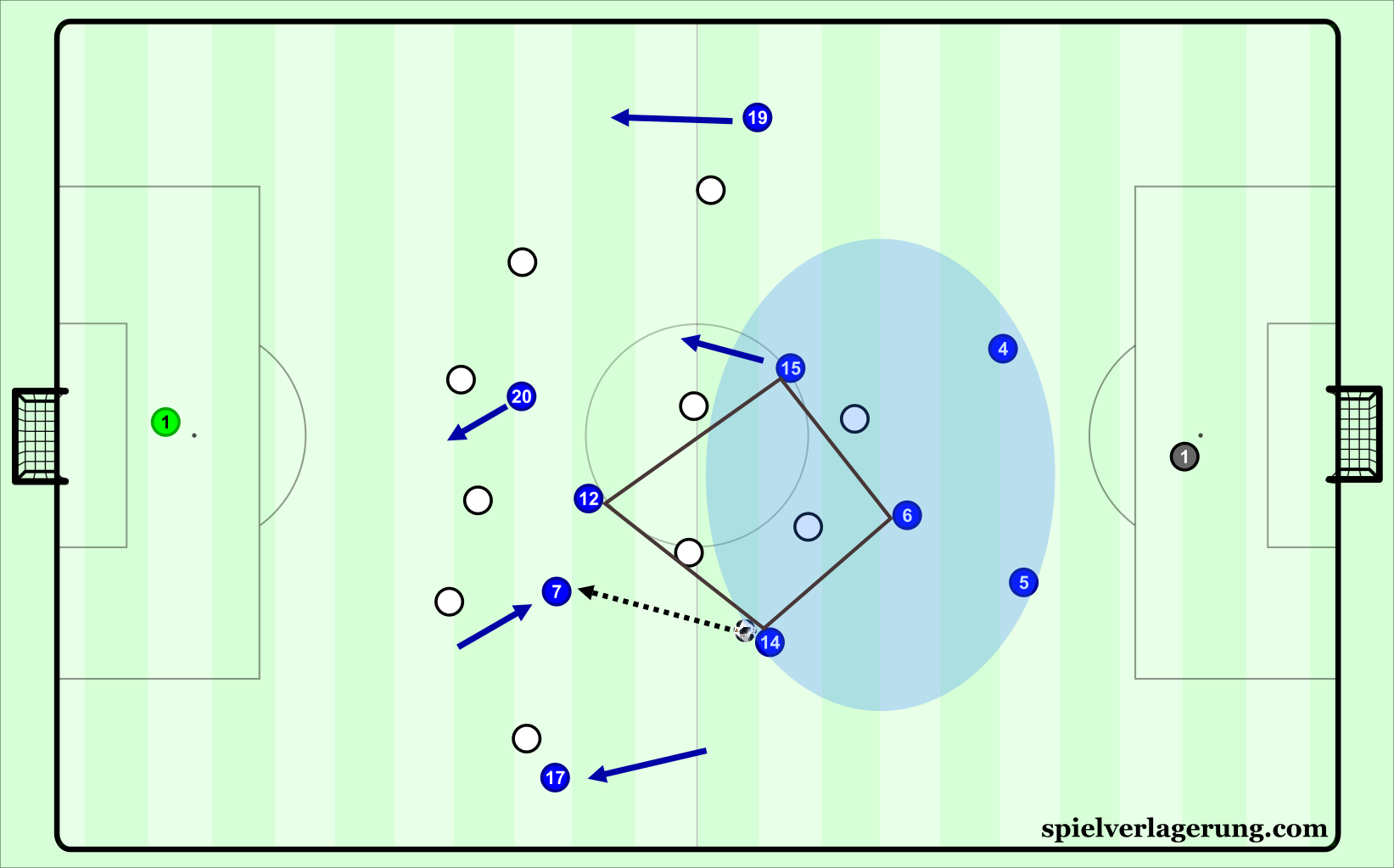
Griezmann previously moved to the left halfspace and interchanged with Mbappe (#12 in this diagram), who became top of the diamond. Once Matuidi plays Griezmann, France move into chance creation mode, with the fullbacks and centre midfielders running up afterwards.
Kante, the deepest of all of the midfielders, checks towards the centre backs to provide a close passing option if desired, remaining as a midpoint between them. To either side of the Chelsea talisman, the centre midfielders will also move toward the ball in pursuit of possessing the ball. France’s centre backs will not play a longer pass if not required, so they more or less have to come deeper in order to get the ball. Situationally, it leads to four or five central build up players in a small area away from goal. This excessiveness is not required for this stage of their attack, and against teams that choose not to pressure the centre backs, it limits the amount of options they can successfully play forward with.
Antoine Griezmann luckily is quite intelligent with his movement when it comes to this respect. As the remaining midfielders aggregate near the defenders, he maintains a distance where he can receive a low risk pass. Thanks to his remarkable understanding of where his teammates and the opponents are, he almost always has perfect orientation when receiving passes to progress the rest of his team up the pitch. Through dribbling to find the next pass or playing one touch out toward the wings, he acts as the cue to move from building up to chance creation. Once the ball flows through him, France shift into higher gear.
Without Griezmann, the other French attackers are unable to replicate the same important role as the ignition to go forward. Fekir offers the closest player profile to be able to fill that role, but the remainder of the French forward line is not as comfortable dropping into midfield to receive the ball. When Griezmann is out of the team, there a void in midfield that makes it remarkably difficult to build up and progress successfully. The front three become fixated with penetrating in behind while the midfielders still drop deep for circulation, creating large distances that separate the team and make good possession play remarkably difficult to maintain. It is these reasons, among many more, that Griezmann is the most vital player in the starting XI, the closest thing to irreplaceable in such a gifted squad.
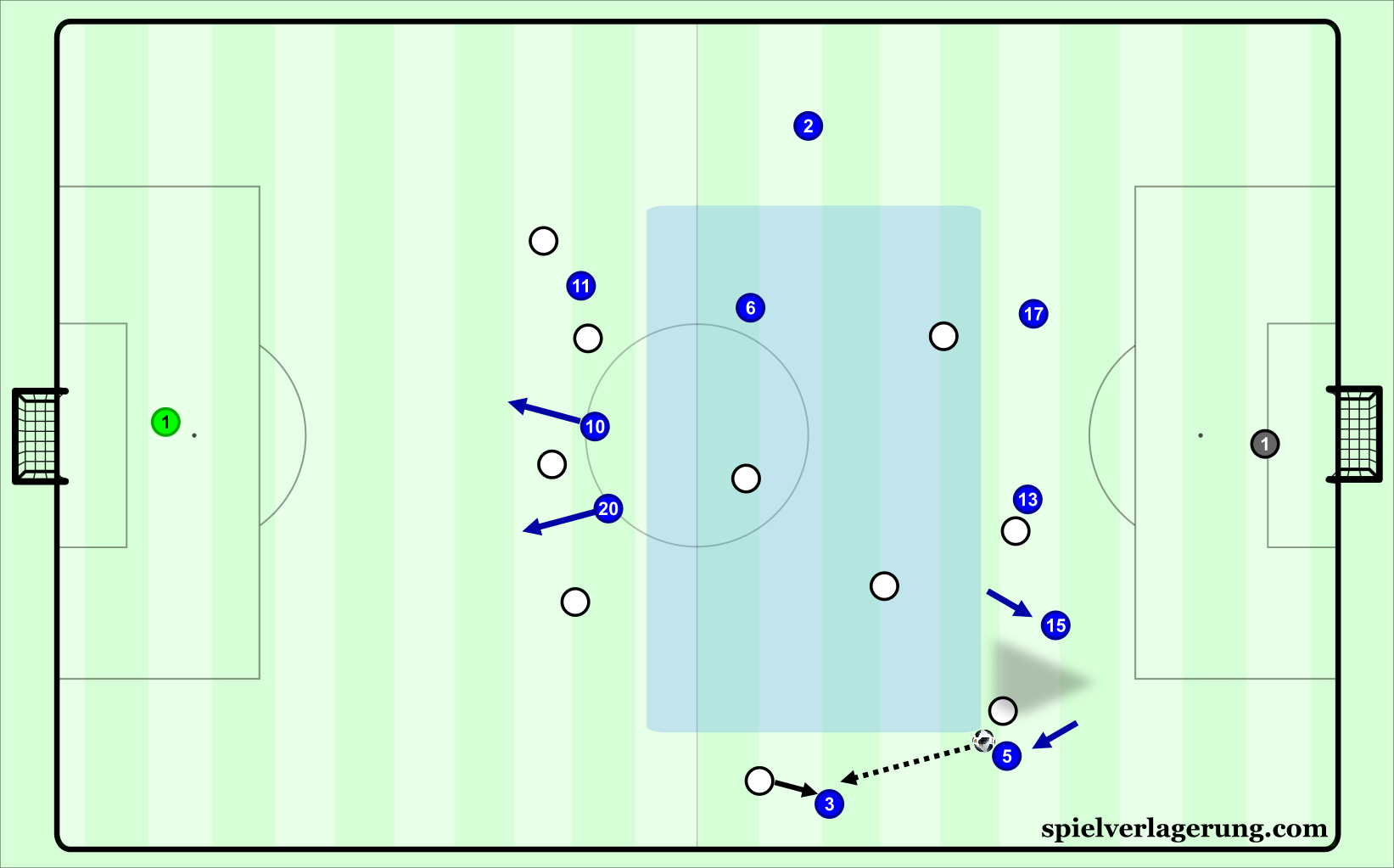
Without Griezmann, no member of the forward line wants to link play between the midfield and forwards. Factor in the overly defensive positioning of the centre midfielders, and Umtiti is resigned to passing to the left back.
Through a combination of patience, proximal passing and positioning, and incremental advancement, France’s play in buildup provides the foundations for the rest of their attack. However, there are still various areas where the overall execution can improve in order to make France more imposing.
Chance Creation & Les étoiles
Once the halfway point has been crossed, the behavior of the team undergoes a shift in terms of movement and positioning. The centre midfielders will move just slightly higher to support the forwards for combination play as Kante remains behind in rest-defense. The fullbacks will move higher into the attack as the wide forwards begin to pinch inside if they weren’t there already. Their starting positions can be varied, as in recent matches, they have advanced all the way to the highest forward line, creating a line of five. Other occasions see the ball side fullback slide higher with the far side fullback starting deeper to move into space as the ball switches from side to side.
In either sense, there is a slight wing focus towards how France create chances. The right side is where Mbappe flies by defenders for creating his own scoring chances or cutting the ball back for others, with the sporadic overlapping movement from the fullback to form wing overloads. When his efforts on the right look unpromising, the ball is simply cycled around, typically through two or three passes onto the late running left back.
Since the winger will be inside the penalty area, the left back is able to run into space without being covered and force the opponents to pressure right away at risk of conceding. The chain reaction from this is marking getting abandoned, and France are able to create from width in this circumstance. For attacks that originate on the left, the ending action is commonly some sort of cross or cutback from the byline in the instance of successfully dribbling there.
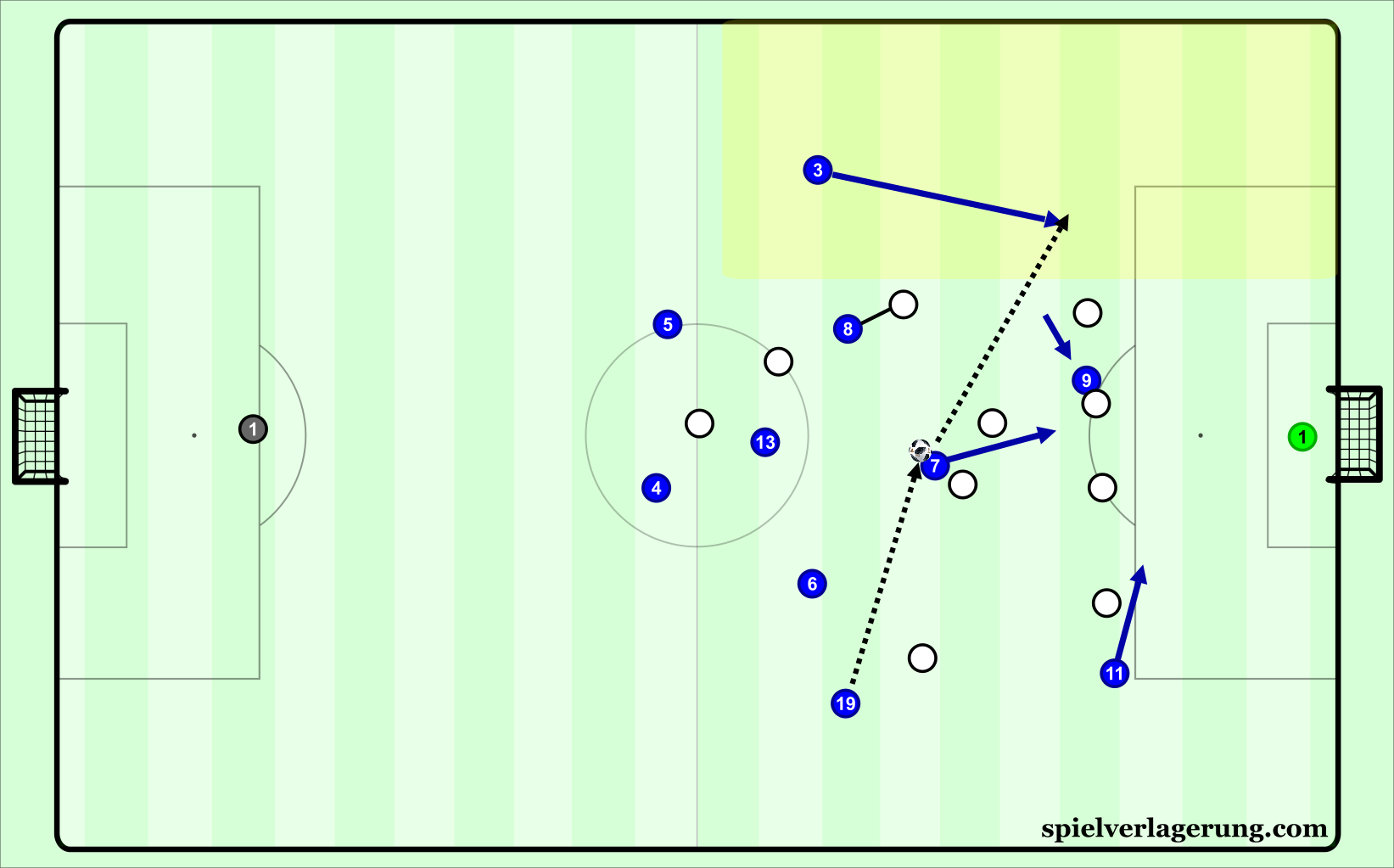
The left fullback starts deeper to be able to run into the space ahead of him marked in yellow. As Giroud moves inside, this opens up the lane further, where Griezmann finds him into his feet before crossing into the penalty area.
Through the centre, the understanding between Olivier Giroud and Griezmann is critical for how France go to goal. With Griezmann being the free player, Giroud’s movement is crucial for occupying defenders that would normally step up to mark Griezmann. If he moves interiorly from the left, Giroud shuffles ever so slightly to move back into the zone that was just vacated. Despite being excellent with combination play and in the air, Giroud’s principle value comes from being the most advanced presence, alternating with Griezmann when goals are in the cards. Without Giroud, the centre backs would be able to step up and mark Griezmann with fewer consequences unless France wanted to play a more penetrative style. Deschamps shows no sign of moving out of the current ways, and for that, Giroud is vital at the expense of Ousmane Dembele.
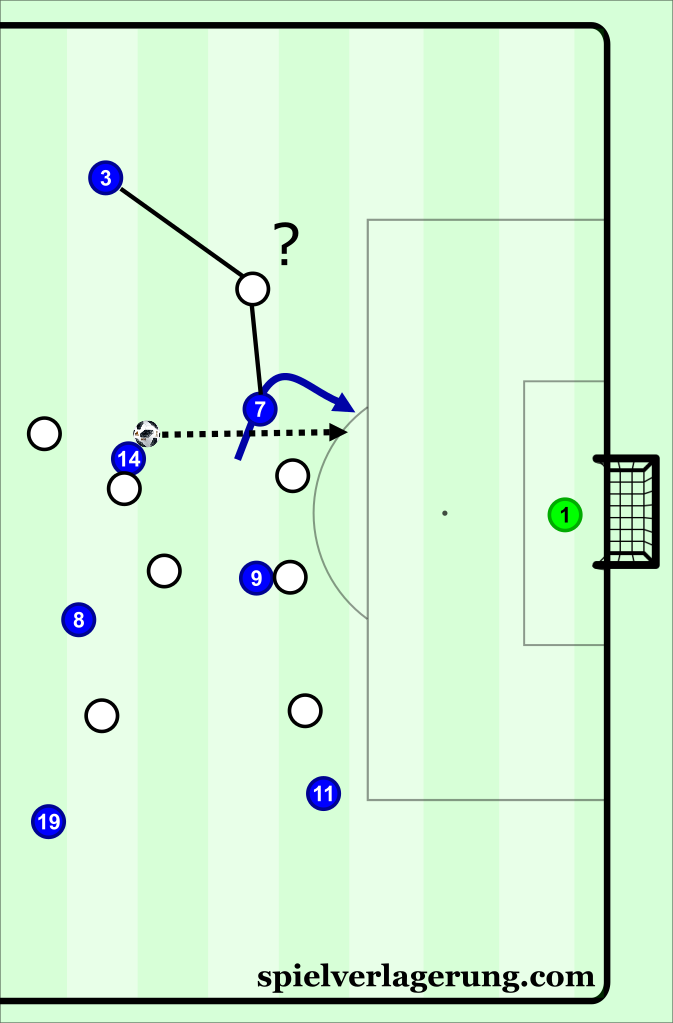
Griezmann here moves ever so slightly away from the right centre back, creating a temporary decisional crisis for the right back as number 3 pushes higher. In this time, Matuidi threads the ball through, and with a deft first touch, Griezmann is able to finish to put France ahead.
In the shift from becoming creator to finisher, Griezmann exhibits several excellent traits that make him a possible contender for the Golden Boot. His finishing ability in itself is quite good, as he displays great composure and accuracy with his shots when close to goal, tucking his efforts just underneath the goalie’s reach. Yet he is able to create these chances thanks to his excellent sense of timing and orientation. Griezmann is a model example of initiating his runs just as his teammate lifts his head up to pick them out. Perfect timing is required for good execution in a smaller space, with he does effortlessly. Griezmann’s orientation is also marvelous. Not only does he also put himself in the gaps of two defenders to force a decision crisis among them, but he additionally squares his body toward the passer and the goal. Once the ball reaches his feet, he is able to take one touch to set up his shot before finishing. It is clean and almost effortless, a true form of French elegance.
Lastly, the most recent preparation friendly brought about concerns about the French’s teams ability to break down low blocks. In a 1-1 draw against the United States, the Americans crowded the penalty area with bodies, with France unable to break through until late. The front players were able to get some shots off, but nothing overwhelmingly dangerous. This may come down to team selection of the other players though, as the midfield dynamic was not ideal for solving this problem.
To destabilize deeper blocks, either a high tempo on the ball is needed or skilled dribblers to be able to attract players toward the ball to free up other teammates. With Blaise Matuidi starting as the left 8, that side was void of much invention and the main subject of Benjamin Mendy crosses. Of all the great characteristics of the Juventus midfielder, not many of them surround his individual attacking quality.
For matches with a highly defensive opponent, Thomas Lemar offers the best dynamic of all the possible left sided 8’s in the roster. His starting position is much higher up in the halfspace than other players who occupy his position, leading to opponents oftentimes having to worry about both him and Griezmann in the ten space. Lemar also is one of the few players in the team that plays through balls into depth. Kylian Mbappe’s speed makes him one of the most dangerous players in the world in these circumstances, and these sorts of passes are criminally underused with this team. Lemar is one of the few players who enhances the play of Mbappe.
Given his role at AS Monaco, he also is capable of playing wide, allowing additional players into the centre when he receives the ball to potentially cross into. Better yet, his mobility as a wide player makes him respond to open spaces quicker than his compatriots in the centre. The attacking minded play of his Monaco side brushes off on this France team when he plays, with his direct runs on the left half of the pitch being so instrumental for crafting goal scoring chances. He may not be as press resistant as Tolisso or industrious as Matuidi, but in every other respect, Lemar offers the most attacking quality among the rest of the midfielders. If France want to spice up their attack in the case of a stale performance, putting Thomas Lemar in the middle should be one of the first changes they make.
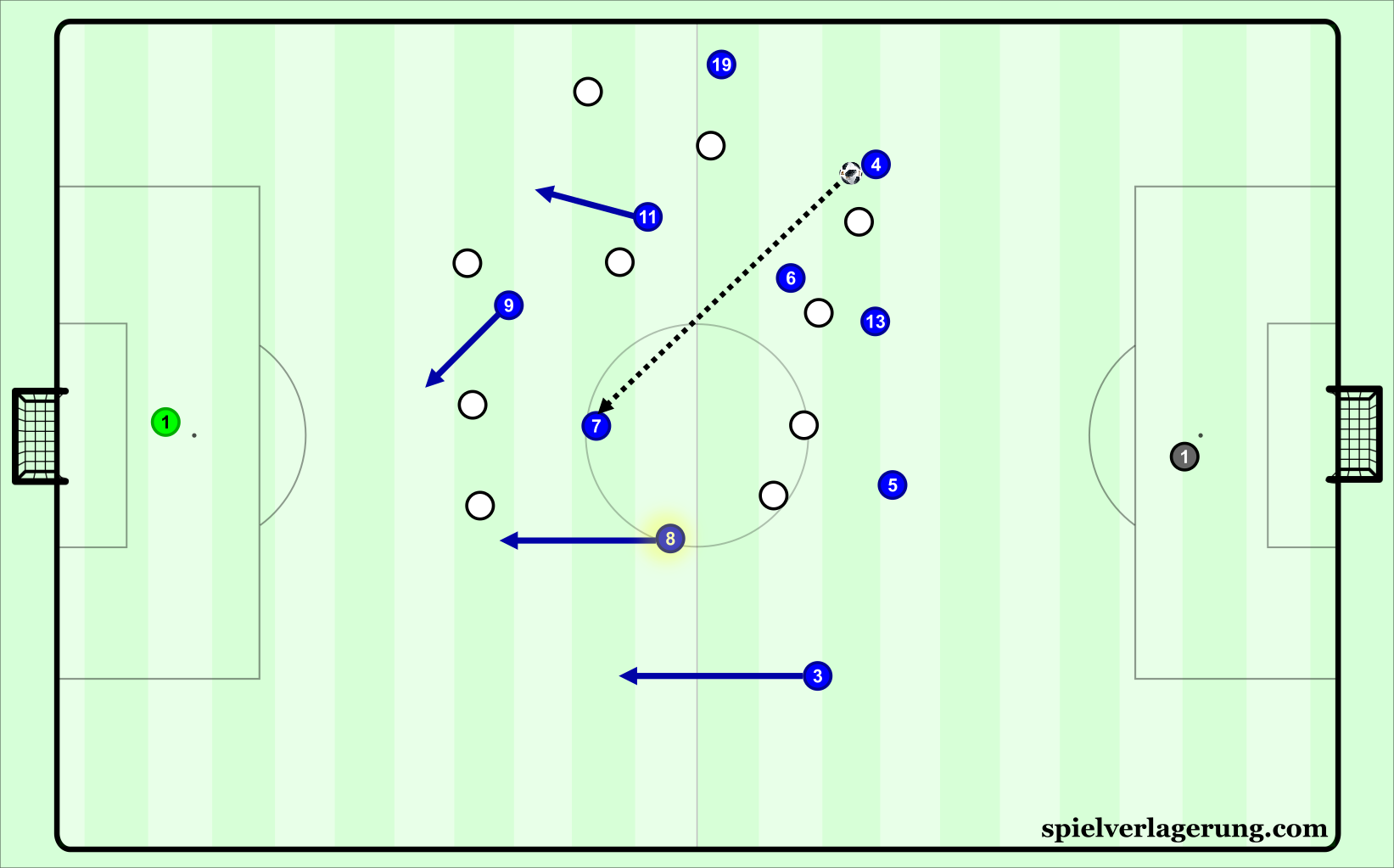
As this pass enters Griezmann’s feet, Lemar is already taking off toward goal. This sort of action is seldom seen among the 8’s, just one way he offers a positive dynamic to the French attack.
French Defense
The defense of Les Bleus shares some common traits with the attack. Despite all the talent they have, there are still some aspects of it that lead to a somewhat lethargic appearance, but it normally does not impact them enough to seriously hinder their chances of winning. In particular, France will oftentimes revert to a passive medium block once possession is conceded, hoping to cover the spaces ahead of the central defenders through short distances between the midfield and defense. Just like the chess opening, the French Defense isn’t composed of complexity and intricacy. That doesn’t mean it isn’t effective against out of sync national teams that lack a Grandmaster on or off the pitch.
France’s block can be varied in the actual formation of it depending on the players involved. In some cases, the left sided 8 shifts wide to become the left midfielder as the right winger joins to form a line of four. This has been the case when Kylian Mbappe is not in the team, leaving France to defend in a 4-4-2. In Russia, Mbappe will be a lynchpin of this team, meaning France’s pressing has subsequently adapted.
Recent matches have seen France defend in a slightly asymmetric 4-3-3. Mbappe will move closer to the middle in order to provide pressure onto centre backs, with Giroud or Griezmann sometimes dropping just beneath him to provide cover. The remaining member of the front trio is situated toward the left. Since Mbappe has such a narrow starting position, teams normally could easily play out to their left fullback (or wingback), who then has a large area to move into once he receives the ball. To solve this, the right 8 has a wider starting position just on the edge of the halfspace, allowing him to have access to both the nearby fullback and the nearest central midfielder when he moves to close down the ball. Since this player is somewhat “cheating” with their anticipation, Kante becomes responsible for a larger territory than before, requiring the left 8 to cover more of the centre and leave the far side wing open for now.
Mbappe’s approach to the ball is more ceremonial than actually a way of forcing the ball carrier to a particular side. In fact, there is little usage of a player’s cover shadow to limit one’s passing options, or even the development of pressing traps. Some traps have emerged during the run of play, but these were largely natural and not reflective of an intentional tactic of Deschamps. Rather, players simply defend the zones they are in, approaching the ball when it is safe to do so and maintaining central stability if they cannot pressure the ball adequately. This can lead to a rather pedestrian affect among the whole team.
Pressure is rarely applied from the front of the team, only done so in the case of the opponent making a mistake or in disjointed, isolated efforts. From a stability perspective, having an unorganized high press opens up strategically valuable spaces in the centre of the pitch. Against Germany in their friendly in November, the front players would move up their lines when Germany passed backwards. However, the midfield and defense failed to do the same, opening up large passing lanes to play into the German midfield, marching up the pitch with ease afterwards.
Some Caveats
Rather than instill a pressing scheme that is organized and generally effective, Deschamps opts to only apply pressure when winning the ball is essentially a certainty. Such instances appear when opponents make bad passes, or pass into tight areas in close proximity to players such as N’Golo Kante and Matuidi, each of them proficient in recovering possession. This is a gamble in multiple ways.
First, it becomes reliant on the opponent making wrong or incorrect choices with their actions. Given that France has oftentimes been the favorite side entering a match, the attacking quality from the opponent is generally inferior and the frequency of incorrect decisions or bad execution subsequently becomes higher. Once these mistakes are made, France are able to recover possession either because of technical errors such as incorrectly hit passes, or the opponents not having the ability to perform highly difficult actions and subsequently losing an individual battle (such as failing to dribble by a player or passing into an area with two players near the ball).
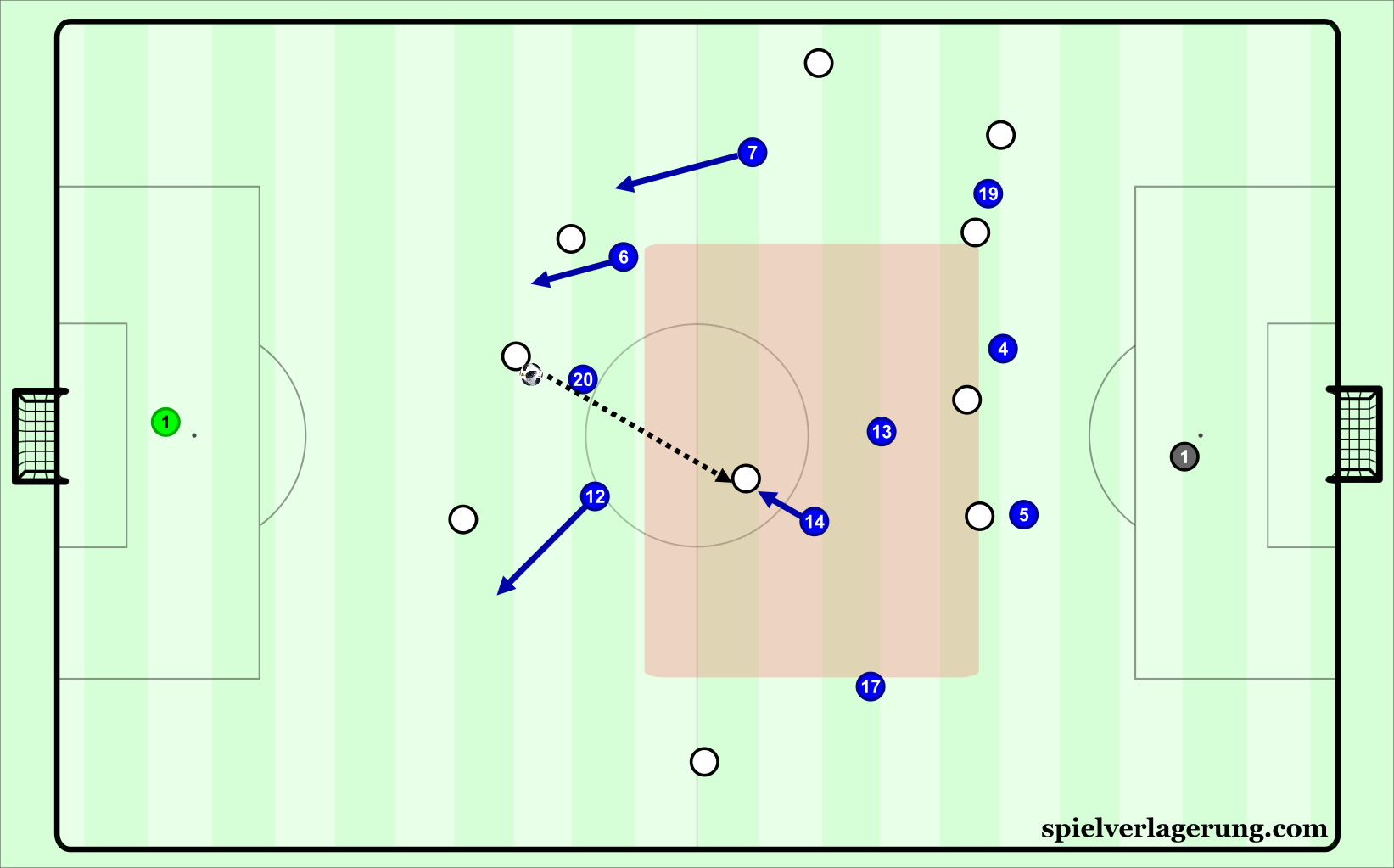
Thanks to the inferior opponent’s woeful attacking shape, France are able to win the ball with little risk involved, subsequently engineering a counter attack.
Secondly, because France are instructed to cover space behind them, they end up in spells defending close to their goal against high-level opponents. The general idea behind defending deep might be having more defenders close to goal is somehow good, but this strategy has had many horror stories surrounding it over recent years. By allowing the opponent to spend more time in their attacking half, the likelihood of randomness or a sequence of play leading to a goal increases. In most matches, they can handle these threats because of the individual quality in their team.
In later knockout rounds of the tournament, the opponents have a better chance of having equally competent players. This will just increase the burden and the amount of pressure on the defensive line to perform well. In the semi-finals of the European Cup against Germany, France were able to ride the wave and subsequently won the match. Such an occurrence is not a guarantee, so leaving the defenders with a lot of responsibility has the potential to go poorly if either an attacker is having an excellent match, or a defender is playing poorly.
But given the decently compact nature of the midfield and defense, breaking them down close to goal is not as simple as it appears. They still have to play through some of the most dominant defenders in the world, and the bottomless source of ball recoveries and energy that is N’Golo Kante. These individuals are paramount to the defensive efforts of the French, especially considering players like Mbappe, Pogba, and Giroud are inconsistent with their defensive intensity and thinking about the next possession once the ball is lost. This double edge sword that France duels with crosses a weird threshold between being structurally stable, but strategically poor.
In summary, France are set up just satisfactorily enough to manage matches against most inferior opposition by having decent structural stability, despite the off and on efforts of some of their front player. Against the top teams in the world, Les Bleus end up relying heavily on strong individual performances and ability to survive, but they can afford to do so more often than not.
Transitions
Counterattacks
Where France truly stand out among the teams in the tournament is with their attacking transitions. Despite all the theoretical drawbacks of defending deep, their defensive disposition helps greatly with their counterattacking. Les Bleus are remarkably responsive once recovering possession in their own half, as once the ball is secured, at least two forwards begin racing towards goal. With lightening fast forwards, defenders face no choice but to delay and hope for the best. It is not out of the ordinary to see one or more of the fullbacks joining the counterattack as well, adding yet another choice out wide to pass to alongside supporting reinforcements from midfield. In the span of five seconds, France might have five players sprinting towards goal to punish their opponent’s mistake.
https://twitter.com/AReynolds70/status/1005840758442807296
Once in the midst of the counterattack, the best abilities of the attacking trio really come to light. Mbappe’s speed over open play, Griezmann’s remarkable timing with his runs, and Giroud’s movement to draw defenders away. The first two with the ball do remarkably well at drawing defenders towards the ball as supporting runners follow just behind, waiting until they can pass as support gets into a space to possibly shoot. Ousmane Dembele is also invaluable in this respect, as his direct running, ambidexterity, and dribbling thrives in the face of opposition disorder.
Considering the amount of open space that is available once opponents concede possession in their own half, it provides a nearly perfect storm for the French counter attacking machine to work its magic. Rarely do teams have players able to keep up with the kind of speed that Dembele, Mbappe, and co possess, leading to them being outnumbered quickly and scrambling to cope with the incoming onslaught.
Counterpressure and Defensive Recoveries
In the way that France’s attacking transitions are must see and keep you on the edge of your seat, their defensive transitions are the exact opposite. Counterpressure is sparingly applied after ceding possession, only really done so in the case of a player losing the ball on the dribble and just in the case of continuing their momentum. Some players will halfheartedly chase the ball just to prevent the first pass from being played forward, but they oftentimes lack any support in these efforts and they are left isolated, rendering them ineffective.
There are some examples of forwards backpressing midfielders when technical errors are made, but the work they put into pressuring the ball is essentially wasted. Players closest to the ball instead generally just delay the opponent. Once possession is lost, the majority of the team just goes back to their defensive starting position in time it takes for someone to restrain the possibility of a counter attack. Understanding the value of transitions, Deschamps avoids the risks that come with being overzealous in recovering the ball right away, perhaps as a primer to make his own transitions that much more fruitful.
Rest Defense
Some of the elements of rest defense were touched upon in the build up section, particularly the deep starting positions of the central midfielders. Akin to Zidane’s Real Madrid, this category of possession makes them remarkably stable and difficult to transition against successfully due to the central occupation. Not to mention the quality at the back of the team and N’Golo Kante.
With most of their opponents playing with one forward, the centre back duo each stays to ensure a numerical advantage and Kante shields the space just in front of them. When more forwards are left higher, more French central midfielders will remain. The main consequence of this is that opponents must counter through the wings if they are to have any chance of success, almost invited to do with the advanced positioning of the fullbacks in attack. The fullbacks can make the trek up the pitch to contribute to the counter attack, so this suggests they should also make the trip back to provide backup and cover if they are not caught too high up and the restraining is well done.
Hypothetical Line-ups
With the overall depth and quality of the French player pool, critics of Deschamps suggest that having a more adventurous style of play and team selection would lead to more dominant victories and better performances from the top players. While it is unlikely that Deschamps ever uses any of these proposed systems, it is fun to speculate and imagine what could result from some different approaches and adaptations with the same roster.
In this system, Pavard at the centre of the back three could give a lot of variations of how France would structure themselves in possession. The central focus on the team is apparent in the personnel choices, all of whom are press resistant and possess a wide range of passing. This would allow France to have varied possession play, able to outnumber opponents centrally and circulate the ball quickly if needed, or change the point of attack and play long passes for teams that are heavily ball-oriented. Griezmann’s would have a free role as a 10 would not be too different to the role he currently has in this French team. Dembele and Mbappe could each provide the runs into depth they each thrive at, putting defenders for a tailspin with the ball as well, with a consistent centre forward presence in Olivier Giroud.
Defensively, simply due to the incredible physical abilities of Varane and Umtiti, they could effectively defend the wings on their own in transitions (provided they are not outnumbered). But without the ball, they would not be able to defend in the same manner as the current French team. Since possession would be such a focus for this team, immediate counterpressure would be essential to this hypothetical team’s success. Through a highly controlling, positional approach in possession, defensive stability in numbers would not be a huge necessity, thanks to the quality of the players alongside a good understanding of how to react when possession would be conceded.
This is perhaps what France would look like if in some parallel universe, Leonardo Jardim was appointed as the French National Team manager after winning Ligue 1 with AS Monaco in 2017. The FFF’s primary request was to recreate the exact same play style in their pursuit of a World Cup victory. Giroud would provide the combination play, movement, and aerial presence of Falcao, with the rest of the team being small changes from his AS Monaco side. What would result could turn out to be one of the most high-intensity, aggressive teams in transition ever seen.
Pogba and Griezmann, who would be among the first names on the teamsheet for most managers, were left off. Pogba could slide for Matuidi’s role, potentially compromising pressing quality for better attacking build ups. Griezmann and Fekir could be a like for like swap, however Fekir has more similarities to Bernardo Silva than the Atletico star, hence the reason he was left out of this fictional team.
There are several other fun possibilities that could be explored with this team, that span a wide spectrum of play styles and philosophies. If stability weren’t such a prevalent focus in high level football at the moment, perhaps we would be able to witness a variant of one of these systems.
Conclusion
World Cups offer a glimpse of what the last four years of club football have developed tactically and can also resemble some kind of stylistic clash between competing methods. To compare this France team to a club is quite easy, as they have many of the same tactical and strategical qualities of Zidane’s Real Madrid. However, Deschamps doesn’t have the luxury of Cristiano Ronaldo, nor the two best centre midfielders in the world to navigate high pressure, so French fans shouldn’t get their hopes up just yet with that comparison. He also lacks the daily training environment that comes with club football, so of course they won’t be able to execute everything as a carbon copy of his former teammate.
But there is a lot to be optimistic about for this coming year. A highly talented roster overall can allow for resting of important players in later group matches if France happen to clinch the group early. In such a tournament, freshness plays a huge role in deciding the final result. The young talent in this team will be eager to announce themselves as the heirs of the Messi-Ronaldo era of dominance, alongside proving to their country that they are the best national side to date. By avoiding serious risks with their play, Deschamps may leave Russia having raised a trophy, or waiving the white flag, wondering what could’ve been with this pool of players.

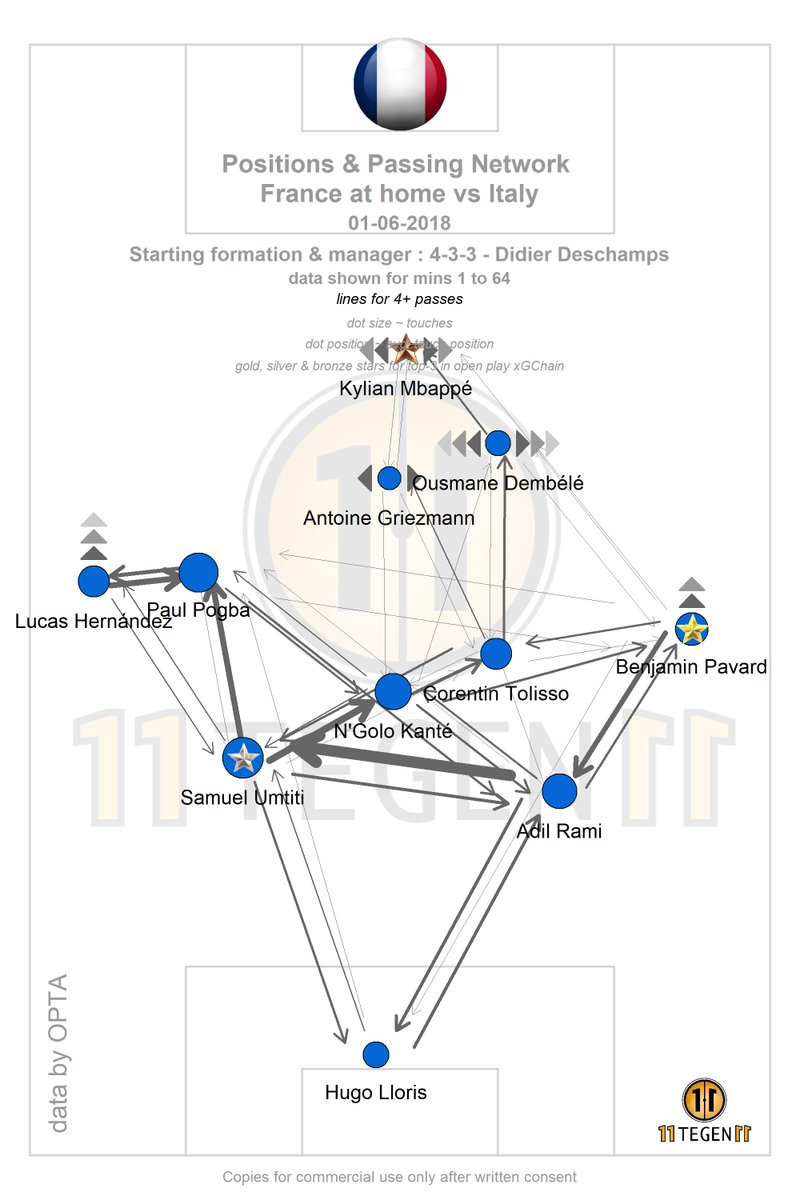
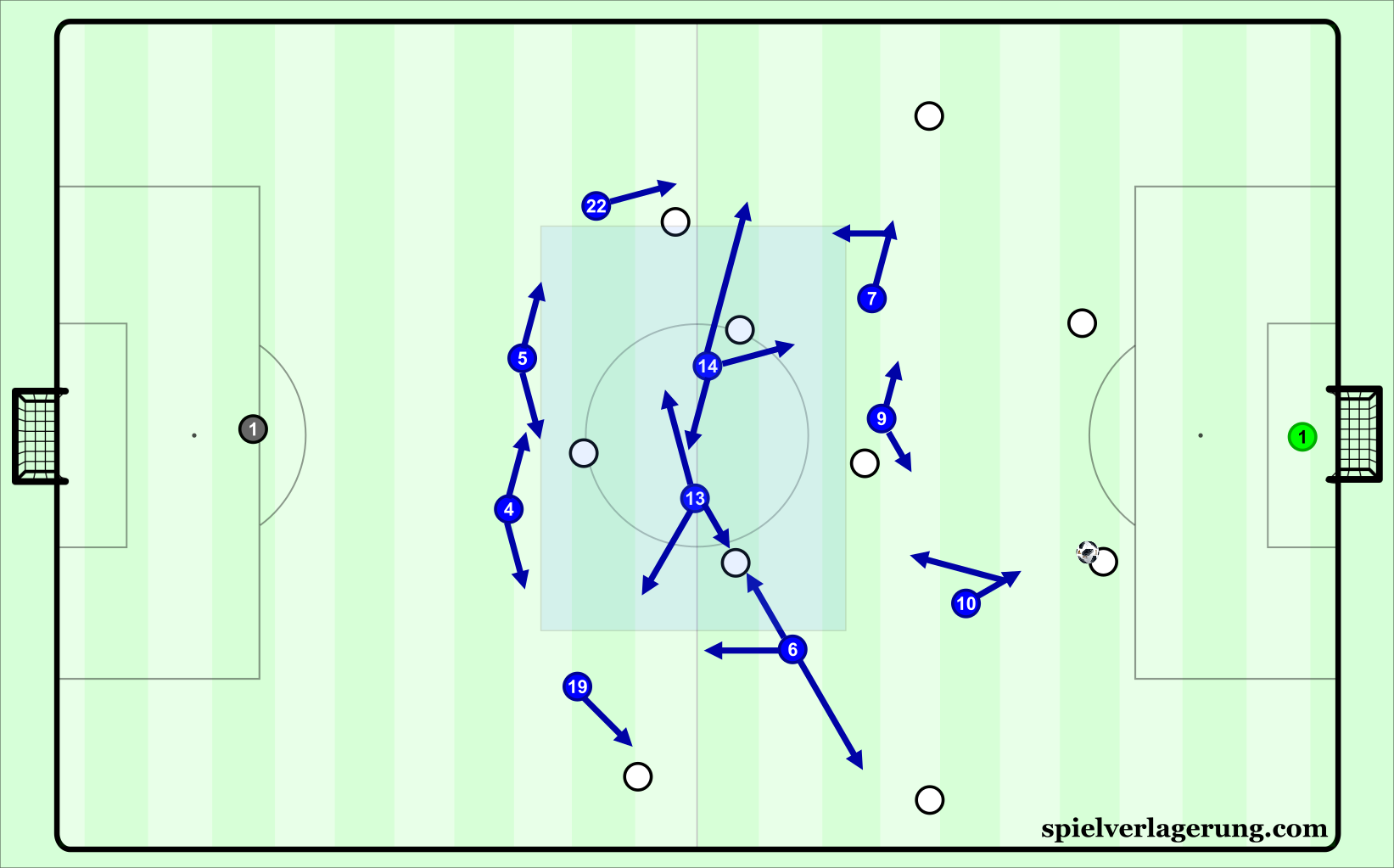

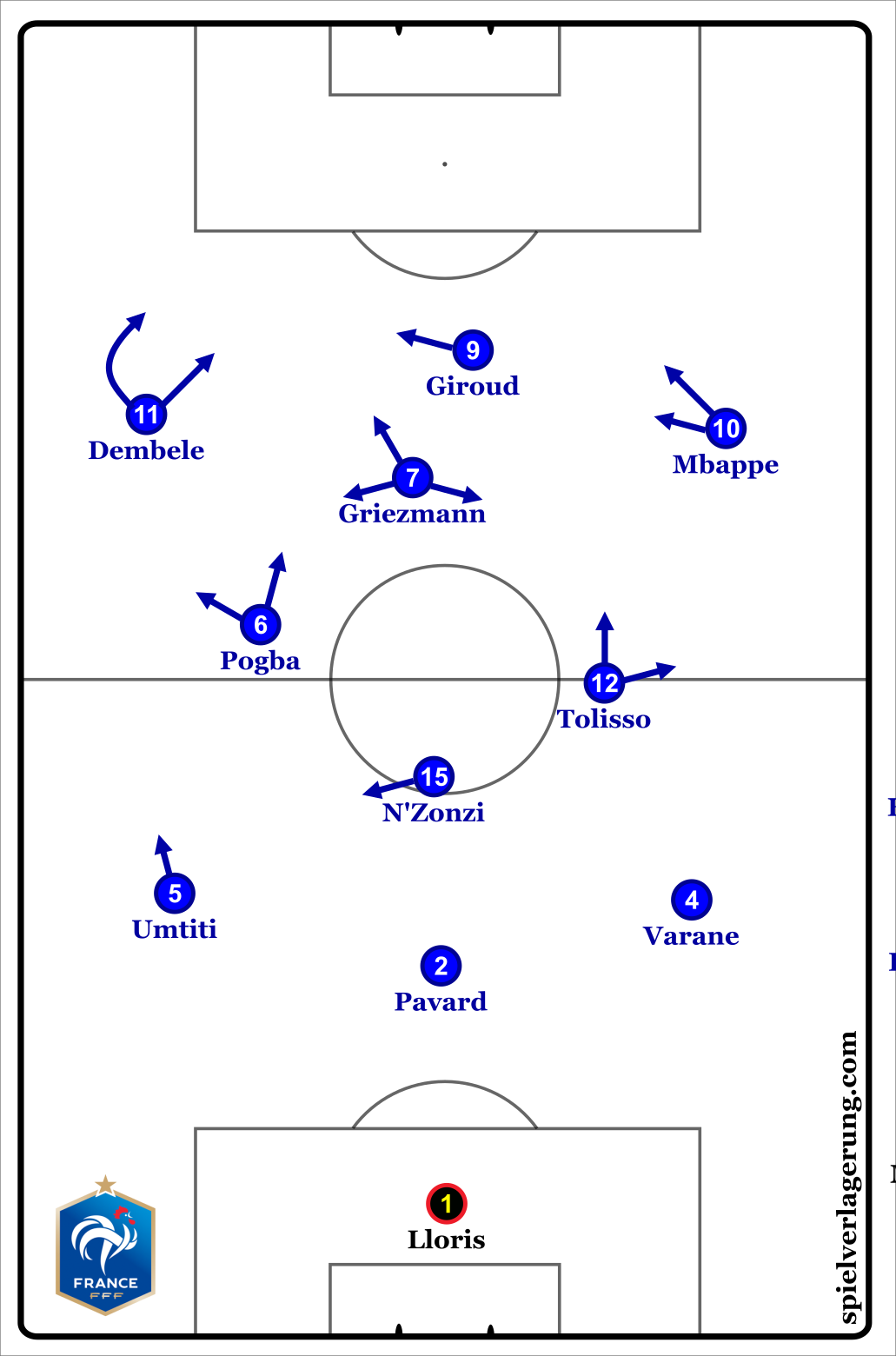
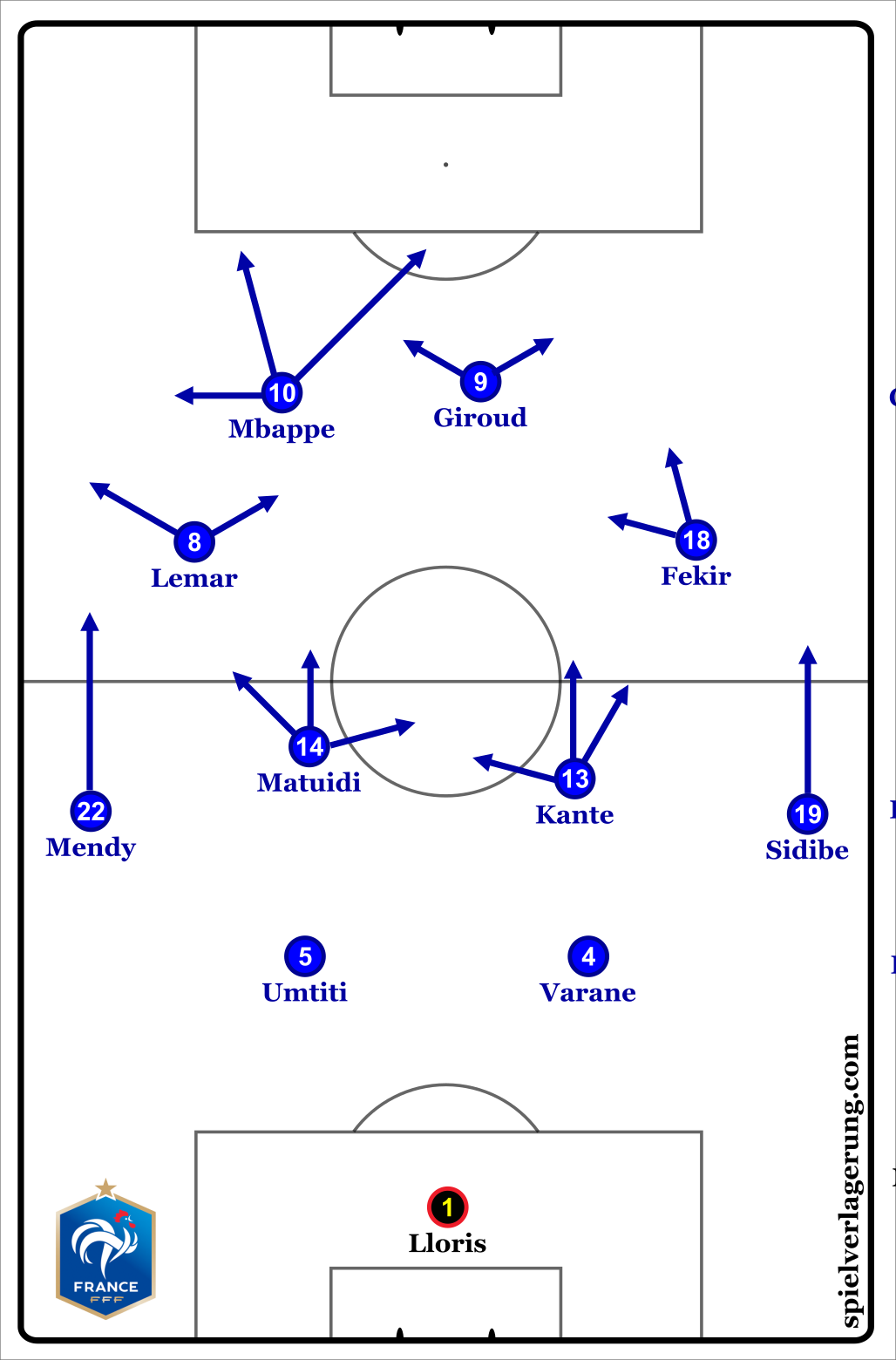
4 Kommentare Alle anzeigen
tobit June 15, 2018 um 2:39 pm
Very nice article!
I don’t think press resistance is one of Tolissos main skills. He is a good passer (but nowhere near world class), a strong tackler and a decent shooter. But (atleast in Bundesliga) his control and swiftness on the ball doesn’t compare to the likes of Busquets, Modric or Iniesta. He also isn’t using his pretty strong body to protect the ball in close situations like Matic or Martinez do. But most importantly: his decision-making is a lot slower than than Kroos or Weigl’s.
Why wouldn’t you play Kante in the 3-Diamond-3 formation? His lack of aerial ability (in comparison with N’Zonzi) should be very tolerable – given he’s surrounded by three CB’s as well as Pogba and Tolisso (who are pretty decent in the air). His strategic approach to controlling space infront of his backline could be far more valuable than N’Zonzis rather chaotic and man-oriented style of play.
AR June 15, 2018 um 11:28 pm
N’Zonzi over Kante purely for possession reasons. N’Z manages being pressed when in deeper spots better I think, as when you have so many players in advanced spots, you need players able to retain possession and move it forward. Kante at times was the cue for opposition pressing, and struggled being targeted like that. But Kante would be quite valuable for counterpressing in this team. These decisions are quite difficult for a fictional team, nevermind a real one where you have to take into account all the other factors that surround selection. A difficult task for sure!
Erwann June 15, 2018 um 11:55 am
Great article ! This is a synthesis of everything I would’ve said about this team for a few years now, but being too fragmentary or unable to put words on some visual impressions. Thank you.
I think you’re a bit optimistic about the defensive stability tho, even against smaller teams. We generally ensure a slow / defensive possession of the ball against them (as you wrote it), but the lack of structure makes us being in danger on every opponent’s counterattack (e.g. against Luxembourg !).
We also played in a kind-of Jardim’s 442 sometimes, the best instance being probably the France-England friendly in 2017. Dembélé’s interpretation of the right offensive midfielder was obviously different from Bernardo Silva’s, but the mechanics of the play were globally the same as Monaco’s. Pogba suited the Fabinho role pretty well btw. The system valued the abilities of Thomas Lemar, halfway between playmaker and winger ; but Lemar’s underwhelming season seems to get him far from being more than a basic substitute for this WC, in Deschamps’ mind (sadly).
Adriel June 13, 2018 um 6:23 pm
I think Benzema might be missed at some point, especially if France performs below expectations. Benzema’s use of the ball in retention is understated (Think of his performance against LFC)
Benzema would do exactly what Giroud does & in a higher level of performance.